Tag: Thomas Edwards ’20
Silenced Sam: Confederate Statue Topples in the Night
by The Cowl Editor on September 5, 2018
National and Global News
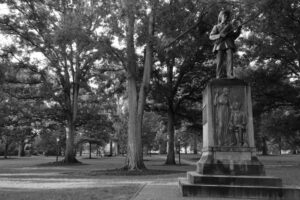
by Thomas Edwards ’20
News Co-Editor
On the night of Saturday, August 20, there was a student rally protesting the Confederate monument, “Silent Sam” at the University of North Carolina at Chapel Hill. The protest ended with Silent Sam laying face first in the dirt; only his pedestal remaining.
Silent Sam was donated to the campus by Julian Carr on June 2, 1913 in order to reconnect young Southerners with their history, according to Carr. “The present generation, I am persuaded, scarcely takes note of what the Confederate soldier meant to the welfare of the Anglo-Saxon race during the four years immediately succeeding the war, when the facts are, that their courage and steadfastness saved the very life of the Anglo-Saxon race in the South,” said Carr at the dedication of the statue.
Throughout the past year, there were several protests surrounding Silent Sam calling for it to be taken down.
“I attended several rallies last year, and it seemed unlikely that this was actually going to be the moment when they toppled Silent Sam,” said UNC student Gracie McKinley when asked about the event. “Most of my friends, many of whom attended previous rallies, were also shocked, although not upset, that it happened the night before the first day of classes so suddenly.”
The protest began and attracted police presence to the statue. Protestors surrounded the statue as others put up polls and drapes covering the monument entirely. With the use of ropes, the protestors pulled Silent Sam from his pedestal. Soon after, the police had the statue removed from campus.
In the week that has followed the event, tensions in and around the UNC Chapel Hill campus have been high, the height of which resulted in an alt-right counter protest this past Saturday. Waving Confederate flags, about a dozen reactionary protestors surrounded the base of the statue and were met by well over 100 students. The counter protest ended when students chased them off campus, according to a report by The Chronicle of Higher Education.
“It was a symbol of racism and I am happy it was taken down, but I am worried that this is just the peak of the iceberg,” said UNC student Robert Piscitelli when asked about the event. “I think it was poorly handled by the state and university and that it should’ve been taken down a lot sooner by them instead of students,” continued Piscitelli.
“We have asked the FBI to assist the police to fully investigate the incident, and they have agreed,” stated Carol Folt, Chancellor of UNC in Chapel Hill in a message to the student body. “While we are grateful that no one, including our police officers, was injured during last night’s protest, we will never condone mob actions.”
The office of North Carolina Governor Roy Cooper put out a statement saying, “The Governor understands that many people are frustrated by the pace of change and he shares their frustrations, but violent destruction of public property has no place in our communities.”
UNC’s student government sent out a statement praising the incident. “Last night, they tore down Silent Sam. They were right to do so.”
There has been an increased police presence throughout campus in the weeks following the event, including state troopers. While an investigation into the event is underway, it has not been made public what the university plans on doing with the remaining base and statue.
Orientation Ushers In Class of 2022
by The Cowl Editor on September 4, 2018
Campus
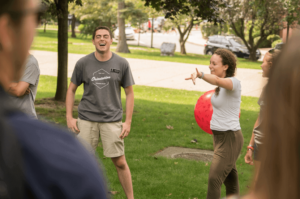
by Thomas Edwards ’20
News Editor
Orientation at Providence College is memorable for everyone. Some memories are fond, some not so fond, but every PC student shares this experience. Orientation provides students with the information they will need to navigate their journey here at PC.
Orientation Leaders (OLs) are at the head of the whole operation, providing their wealth of information and expertise as PC students to their groups of roughly 30 freshmen per 2-3 OLs.
These OLs are responsible for attending planned activities with their groups such as casino night. OLs share their expertise with new students through an activity called “Tough Questions,” in which new students ask questions anonymously to their OLs. “It’s the stuff that, you know, of course they don’t want to say out loud or even want people knowing is their question, but it’s questions they really want answered. After doing that session I left and I really felt I helped people today,” said Steven Sawan ’20.
Amanda Piechota ’19 added, “To speak and watch a group of disinterested kids stop and intently register with the words that you’re throwing at them, to become engaged with you. This was very humbling for me.”
Among the staff are Orientation Coordinators, a group of five students who do not lead groups, but instead lead orientation as a whole. They develop the orientation programs and activities, as well as oversee the events during orientation week. This year they included a new workshop regarding mental health called Pause and Be Present at PC. “It was a mindfulness-based exercise workshop,” stated Orientation Coordinator Ariana Tomasi ’19. “As students we’re always go, go, go, and stress but social life with academic life and organizations, clubs. [The speaker] gave students techniques and exercises to be mindful and to breathe and to come back to a space of peace and quiet that you can practice throughout your time at college,” Tomasi continued.
Some universities have their freshmen come a week before classes begin to have a week-long orientation, instead of breaking it up into two weekends as is done here at PC. “It is nice to have a break between the two,” said Caprial Harris ’19. “The first four days can be pretty overwhelming for students, so having a break is definitely needed.”
Michael Oross ’22 stated that, “Knowing what I think this weekend entails, if they were to try and put that all in the days we had, I think that would be way too much and we would all be absolutely exhausted.”
When questioned about the overall effectiveness of orientation, freshmen and OLs agreed once again.
Harris said, “I didn’t really make an effort with my orientation or let my OLs help me. Now being on the other side of it, I understand where students are coming from, but we are here as a resource and we want students to ask us for advice and ask us questions.”
Oross added, “I went from my first day being incredibly nervous and anxious, and everyday it’s gotten much, much easier. So, I do think it did a lot of good.”
When asked about how they might want to see orientation change in the years to come, many felt that it was in a good place. One suggestion came from Piechota. “I wish that the administrators were around to speak to the kids a little bit more,” said Piechota as she recollected her freshman year orientation in which Dean of Students Steven Sears and Father Cuddy, O.P., gave a talk on student life. “They were two administrators who showed that they really understood student life. They didn’t skip around anything, and the way they painted Eaton Street and your first couple of nights freshman year was pretty funny, and it was just down to earth.”
The biggest criticism, however, came from Harris, “As an OL, I wish orientation was even longer than it is, because I wish I could spend more time with my group!”
The NAACP Sponsors Lecture by Harvard’s Sa-Kiera Hudson
by The Cowl Editor on November 16, 2017
News
by Thomas Edwards ’20
News Staff
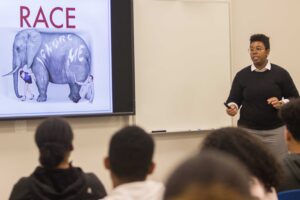
Colorblindness; no, not the inability to see certain colors due to an abnormality in the retina, but the conscious decision to avoid taking someone’s race into account.
On Wednesday, November 8, Providence College’s National Association for the Advancement of Colored People hosted guest lecturer Sa-kiera Hudson—a fourth year Ph.D student at Harvard University studying psychology, race, and sexuality—to speak on the psychology of colorblindness.
Hudson began the lecture by describing colorblindness as “the same idea as the genetic disorder,” where you cannot tell the difference between races. The idea is to not use racial differences or racial groups when making decisions. Hudson explained it as “intuitive not to categorize people” if you want to make unbiased decisions.
Hudson noted how defining someone by a race will activate stereotypes. She said that often those who use colorblindness “want to minimize harm” and that it is “linked to egalitarian views.”
After this brief introduction, Hudson quickly showed a series of faces and proceeded to ask who could tell her anything about the last face.
After a few moments of no one saying much, one brave soul raised their hand and answered “they were black.” Hudson’s point here was to show that it is impossible to not see race and that being colorblind is “really just ignoring something.”
She went on to explain how colorblindness does not just ignore race, but it ignores the history behind the particular race and their struggles in the face of opposition. Hudson continued to explain that oftentimes people identify with their race, so to say you do not see race is to say “you don’t see me.” Hudson equated it to saying, “I don’t see athletes,” a group people often identify with.
Hudson then went on to discuss how psychology has dealt with the issue of race and colorblindness. A study used the children’s game “Guess Who?” in which you have a questioner and an answerer —the questioner asks questions about people on pictures that the answerer sees and the answerer will inform the questioner if and when they have gotten something right about certain pictures.
In the study, they used white Americans who identified as colorblind as the questioners and used an assortment of black and white Americans as the answerer.
The study found that when it was a white answerer, the white questioner would be more likely to ask race of the person in the pictures—93 percent. When it was a black answerer, however, the white questioners were 64 percent less likely to ask the race of the person in the pictures.
Hudson defined this as “strategic use of colorblind label.” The study also found that the black answerers were affected by the white questioner’s avoidance of race questions in a negative way; Hudson defined this as “negative non-verbal bias,” or when someone actively avoids discussing something obvious and the other person can see this and is oftentimes made uncomfortable due to mixed signals being sent and will lead to them becoming exhausted.
Hudson went on to explain that the use of colorblindness also increases racial bias as it “ignores the problems facing minorities” and “removes race as an explanation” so we are led to think poorly of someone.
Hudson explained that this use of colorblindness could cause the majority to partially disregard the history of racial discrimination that negatively effects minorities; “this will cause the minority to blame themselves,” explained Hudson.
She equated it to losing weight, “Say I want to lose weight, I can say calories don’t exist so I can’t gain weight now. But, since they still do exist and I will then continue to gain weight I won’t be able to recognize why I’m gaining weight if I don’t believe calories exist.”
Hudson then went on to discuss how colorblindness was “like giving a bird, a monkey, and a fish a flying test. It’s the same test for everyone, but we all know who will pass.”
Hudson ran a bit of a test by testing our “priming,” or unconscious/implicit association of certain things with good or bad. She ran an implicit associations test in which she showed the audience a series of bad words, such as vomit, and good words, such as peace; then she showed the audience stereotypically black names and stereotypically white names. She had the audience slap their right leg if a word had a bad association and left if good, then she had everyone slap right if it was a white name and left if it was a black name.
Hudson then had the audience slap right if it was a good word or a white name and left if it was a bad word or a black name. Finally, she had the audience slap right if it was a good word or a black name and left if it was a bad word or a white name.
Each time the audience participated, Hudson measured reaction time. The test results found that the audience took more time when they had to associate bad words and white names and good words and black names than when it was the other way around. Hudson argued that this was due to how races are represented in the media; she argued that with so few famous blacks when compared to whites it is difficult to associate good with black.
Hudson closed her lecture by giving a different option than colorblindness: multiculturalism. She explains that multiculturalism embraces cultures instead of molding them all into one. It addresses the elephant in the room and allows people to be color conscious and be more comfortable asking questions and talking about differences when in the position to do so instead of ignoring it all. She encouraged people to explore implicit biases they might have, to understand and be more knowledgeable.
For those wanting to take an implicit association test, visit https://implicit.harvard.edu.
PIRC Encourages Students to Drop the I Word
by The Cowl Editor on November 2, 2017
Campus

By Thomas Edwards ’19
News Staff
On Thursday, October 26, 2017 at 6 p.m. in the Ruane Great Room, the Providence Immigrant Rights Coalition hosted a panel discussing the use of the word “illegal” when referring to undocumented immigrants.
Speakers at the panel included Father David Orique, O.P., an assistant professor of history and director of Latin American Studies at Providence College, Dr. Jonathan Dator, staff psychologist, and Dr. Anthony Rodriguez, an assistant professor of elementary and special education. Members of PIRC asked the three panelists a series of questions regarding use of the word “illegal” before opening the floor to students in attendance.
First asked was the question of why the word is commonly used to refer to undocumented immigrants. Fr. Orique was the first to answer saying it is “dehumanizing to call someone illegal.” He went on to say it is “a way to put somebody ‘in their place.’ To let them know they’re different than us.” Dator expanded on Fr. Orique’s answer by adding some people use it because it is “all they’ve ever heard, [they] assume it’s all there is to say.” He did add, however, that some do know that there are other terms and still use “illegal” for political reasons.
“Illegal sounds bad,” said Dator, “if [I] use the word, it’d create the response I want.” Rodriguez expanded further saying “there is some innocence, but a lot of spinning and politicizing” when referring to politicians using the term in order to keep people from belonging. Rodriguez went on to say that “when talking about divine right, only Native Americans belong here.” Rodriguez concluded that “A more specific thing to ask is ‘do you have papers?’ [But] we don’t want to be precise so we use words that hurt.”
The panelists were asked what the legal implications behind the use of the word illegal were. Fr. Orique answered by saying when people refer to laws they are “usually talking of positive law [made] by people. Less than 100 years ago women could not vote, but we can agree now that it was wrong and so eventually the laws were changed. The same was with slavery.”
Fr. Orique went on to talk of how it is “unnatural to tear families apart,” and also said that the Bible teaches us “it is wrong to oppress the resident aliens.” Fr. Orique then went on to discuss the Catholic Church’s response to the rescinding of DACA, calling it a “reprehensible act” and explaining how Pope Francis responded to Trump’s decision.
Fr. Orique paraphrased the Pope’s response as “Trump claims to be pro-life but doesn’t respect all life. On a natural level we shouldn’t harm others.”
Dator said that people need to follow laws but that “migration is not a crime so it cannot be called illegal because it never is.” He went on to say “any reputable publication would never use the term.” Dr. Rodriguez said that “immigrants come seen as ‘an other’ no matter the ethnicity.”
When asked what the effect of the word has on people, Dator was the first to answer. Dator said, “Language and words are so important when you tell the story for someone,” when referring to how we talk about immigrants instead of hear from them. “You set the standard and they start to question themselves and believe the narrative we set for them.”
Dator went on to explain the importance of using “person first dialogue, saying ‘that person with a disability’ instead of ‘that disabled person.’” and doing the same when talking of undocumented immigrants.
Fr. Orique added that we should not dismiss this as being too politically correct. He addressed that “dismissing someone as PC sweeps something very complex under a small rug.” Fr. Orique continued to say “language is complex and can be used to heal or hurt. Weaponized language is a misuse of power.”
Rodriguez added that this is “similar to ‘drop the R word.’” He said that the word “illegal” has “damaged so many peoples sense of self,” going on further to talk of the use of language to “isolate groups, making it easier for ‘conquest.’”
The panel closed by answering the question “What should we call undocumented immigrants on campus?” and the follow up, “How do we stop the use of the word ‘illegal’ when referring to undocumented immigrants?”
Fr. Orique gave the simple answer, “Ask them what they want to be called,” when answering the first question; he added, to help stop the use of the word, we should “be tough on the problem but soft on the people,” encouraging us to open dialogue with people instead of shouting matches in attempts to educate.
Fr. Orique gave the example that most people think of gun violence when thinking of Mexico, but “80 percent of gun violence in Mexico is from guns from the U.S. due to our lax gun laws.” Rodriguez said to “make immigrant a positive word, and ask what they want to be called.” He went on to say to combat the use of the word we should “call people out and explain why it’s bad.” Dr. Dator stated that we should call them “students, just as we do anyone else on campus.”
PC Welcomes Cheryl Granai
by The Cowl Editor on October 26, 2017
Campus
By Thomas Edwards ’20
News Staff
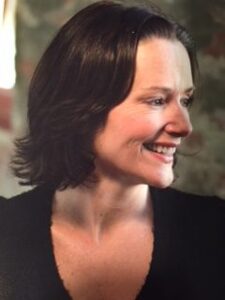
Cheryl Granai, a mental health counselor with a background in nursing, has been hired by Providence College as the Coordinator of Outreach and Prevention in regards to suicide. Granai’s role is to “Sort of keep the project going,” and “contribute to some of the new and innovative trainings and programs we come up with along the way and identify where our needs are.” The project Granai is referring to is that of increased awareness of suicide prevention on PC’s campus.
Granai will also be involved with reaching out to the PC community as well as other colleges in Rhode Island who did not receive the grant but wanted to be involved with the project.
She is working with Dr. James Campbell, assistant vice president for student development and compliance, on the Garrett-Lee-Smith Grant here at PC. Campbell wrote the grant last fall, submitted it in December, and in May PC was awarded the grant.
Since May, they have been “ramping up and moving in a number of directions simultaneously,” said Campbell. The College has begun to receive funding in the last few weeks. The grant is described as follows: Providence College will establish a comprehensive, integrated wellness promotion and suicide prevention program, offering a full spectrum of preventative interventions, ranging from the individual to the ecological.
Commenting on the goals of the grant and project, Campbell stressed the focus on prevention. “The goal includes helping students develop the skills and resilience, the capacity to regulate emotion and move through challenges and crises, and sometimes with help but also having more of a sense of self advocacy— ‘I can do this.’” Campbell went on to say, “It is hard to hire enough counselors and psychologists to cover the need.”
Regarding spotting signs of distress and reacting appropriately, Campbell believes that psychology is at the point where they finally have “the knowledge, research, and ideas to help people do that.”
Campbell and Granai would like to try and implement that here at PC, making sure they cover all corners of campus so that all students, whether they be new students, seniors, LGBTQ, black, white, student athletes, and everything in between, have a sense of belonging on campus and a place to go if they need help.
Granai and Campbell hope to give all students access to someone who can support them, while also helping students, faculty, and staff be able to recognize when a peer is in distress and to be more confident in reaching out to them to help. “Usually when students are in distress, it’s peers who will become aware of it first,” said Campbell, “and so we want to provide more resources for those folks to feel ‘Okay, I know how to help them.’”
Granai went on to add that, in addition to prevention and coping, the project also looks to “work on more broader issues like healthy relationships, or how to be happy… which is a very big movement right now. This whole notion of happiness and how do you incorporate elements of that into your life, wherever you’re at.” The goal is to help students with their outlook on current situations in their life, and, as Granai said, “to sort of change the lense. To change your focus, as opposed to the focus on what’s wrong with this, the focus on what’s right with this and how has it been right in the past and how have I coped in the past.” Granai explains “a way of presenting material that’s hopeful.”
“It doesn’t ignore what we’re trying to do, which is to prevent suicide, but it also takes into account that we can’t solve all of this in a counseling session one on one because we don’t have those kinds of resources, and that most of the student body, 80 percent, won’t step foot in a counseling office. So, how do you help them? We’re looking at it to be specific and broad at the same time. And hopeful.” Granai, to clarify on their prevention goals, said, “Someone who is suicidal can be treated, and success with that treatment is very positive.”
Campbell added that most people who are suicidal suffer from a mental illness, such as depression, which is treatable. Often because of discouragement people with mental illnesses or suicidal thoughts do not seek treatment, so the project hopes that with increased awareness people will understand that a workable solution exists.
The project and grant will run from September 30, 2017 to September 30, 2020. At the end of the three years, Campbell and Granai hope to have a structure in place that, going forward, will be able to help students, faculty, and staff recognize signs of distress in peers, how to help them, and increase community awareness and support for students for years to come.
Granai says, “There’s a notion of sustainability. When you start developing programs, sort of train the trainer. If you have faculty doing the initial training, then you’ll train students to do the training and then you’ll have the students train [other students]. It’s a way of sustaining a program and making it sustainable over time when you are dealing with populations that are coming and going as they are here.”
PC Celebrates Spirit Week and Madness
by The Cowl Editor on October 20, 2017
Campus
by Thomas Edwards ’20
News Staff
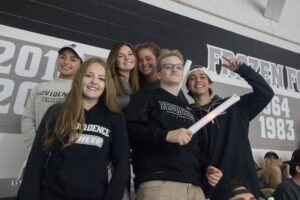
Last week, Providence College welcomed this year’s athletics with the first ever Spirit Week.
The week kicked off with PC’s Men’s Soccer game against Brown at 7 p.m. and “Pink Out Friartown” where Friar’s wore pink to support the team. PC won 2-1 in overtime. Thursday brought about painting PC’s new Friar Fanatic student section banner on Slavin Lawn.
Friday, PC encouraged everyone to wear black and white throughout the day in preparation for the PC Field Hockey game vs. Georgetown at 6 p.m. and PC Volleyball game vs. Xavier at 7 p.m.; Field Hockey won 4-3, Volleyball won in 4 sets. Men’s Soccer played again on Saturday defeating Seton Hall 3-1 before kicking off Late Night Madness. “We thought bringing in a big performer for Late Night Madness would really cap the week really well,” said Dean of Student Affairs Steven Sears. Lil Uzi Vert performed at Late Night Madness to a packed Peterson Center.
Following Late Night Madness on Sunday was the Women’s Soccer game vs. Georgetown, winning 1-0. Volleyball lost to Butler 3 sets to 0. Men’s Hockey lost to Boston College 4-3 in overtime.
What brought about the first ever Spirit Week was student affairs and athletics working together to “do more and more in getting students to see what’s out there in athletics and have better experiences,” said Dean Sears. “By combining our programming and putting on really good events not just going to a soccer game but having food and having different types of drinks and even bands at events, we have found more and more students are coming to watch the Friars play.”
The reasoning behind the recent collaboration between student affairs and athletics is a want for students to “go to a game and really experience being a Friar,” said Dean Sears. PC wants to really bring its student community together as a whole at these events. “The only thing we all have in common, no matter what, we’re all Friars, and that’s what we want, we want that commonality, something that we all see in each other,” said Dean Sears describing the goals of the “perfect marriage” of Student Affairs and Athletics.
“Spirit Week is just the beginning,” said Dean Sears. Moving forward from Spirit Week, student affairs will assess every aspect of the week to see where they can improve for next year’s Spirit Week and events this year. For the remainder of this year the focus will be on marketing certain games to get as many students as possible to really drive home the Friartown spirit.
As Dean Sears put it, “Looking at what went well, taking counts, assessing, asking students, getting input, did this work well, was this food good, should we have had hot dogs and hamburgers instead of pizza, these little things matter.” Moving forward, McPhail’s will begin having hockey and basketball viewings for away games so students can still gather and be involved.
The goal of the alliance between student affairs and athletics is to really build that Friar spirit that’s here all the time. Whether it be through events going on all around campus, or just posters, for students to be able “to know they’re in Friartown without even thinking about it.”
Panel Breaks Down DACA
by The Cowl Editor on September 28, 2017
Campus
by Thomas Edwards ’20
News Staff
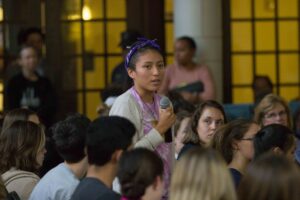
Since the Trump administration announced their intention to end the Deferred Action for Childhood Arrivals policy, DACA has been at the center of the news. On Thursday, September 21, at 4:30p.m. in the Ruane Great Room, the Providence Immigrant Rights Coalition, along with the Office of Institutional Diversity at Providence College and Student Affairs at PC, hosted a DACA discussion panel moderated by Kara Cebulko, associate professor of sociology.
The panel included Javier Juarez, a DACA recipient who currently attends Brown University, Harold W. Pike, Esq., an attorney from Green and Spiegel LLC in Providence, and Jonathan Dator, a licensed psychologist in Rhode Island and current interim associate director of training for personal counseling at PC.
The panel opened with Cebulko giving a brief overview of what DACA was, the events leading up to its creation, and the current immediate aftermath from its removal.
Afterward, Juarez gave a brief overview of his story as a DACA recipient. Prior to DACA, Juarez graduated high school, but since he wasn’t a citizen, he could not attend college. When DACA was initiated in 2012, Juarez was able to get a work permit, earn enough money to put himself through community college, all without financial aid, as DACA recipients are unable to receive Federal Financial Aid. Juarez was able to use the associate’s degree to continue working and further his education and is currently enrolled as a student at Brown University.
As an undocumented immigrant, Juarez said it was “not an option” for him to get a regular job. Rather, it was his responsibility to better himself through education to help his family and his community as a whole. Thanks to DACA, he has been able to work toward that goal so far; however, he now feels uncertain about the future.
Dator was next, and was asked about the mental health impact of removing DACA. Dator told the story of someone he knew by the name of Joaquin before DACA was enacted. Joaquin wanted to be a civil engineer, but, with no opportunity presented to him to achieve this goal because he was undocumented, he saw the future as being hopeless. Eventually, Joaquin committed suicide. Without opportunities, “people feel anxiety, monetary distress, physical distress,” said Dator, and with these added stresses, people like Joaquin are driven to suicide.
After DACA was put into place, according to Dator, studies found that mental health improved in immigrants with the increased opportunity and support provided.
Dator also referenced a Stanford University study published in Science Magazine on Aug. 31 of this year which studied the mental health of children whose parents are recipients of DACA. The study found that children whose mothers were recipients had a lower chance of being diagnosed with a mental disorder.
Pike discussed the legal side of the situation. To be eligible, one must be “under the age of 31, have come to the U.S. before they were 16, lived in the U.S. for five years, no felony or significant misdemeanor convictions, and either be in school or have obtained a degree,” said Pike.
He went on to explain that DACA only granted work permits and protected you from deportation as your information will not be sent to Immigrations and Customs Enforcement (ICE). DACA, Pike explained, “acted like a shield.”
When the audience was given the chance to ask questions or give comments, Father David Orique, O.P, the director of the Latin American Studies program and history professor here at PC, was quick to give the first comment on the stance of the Catholic Church, saying that the act of rescinding DACA was “contrary to divine law to repress the aliens,” said Fr. Orique, referencing the Bible verse which tells us not to repress the aliens in our lands.
He went on to say it went “against natural law to separate families,” and that “Cardinals came out saying it was reprehensible to remove DACA.”
Bursting the PC Bubble
by The Cowl Editor on September 21, 2017
National and Global News
A Timeline Of Recent Events Involving North Korea
By Thomas Edwards ’20
News Staff
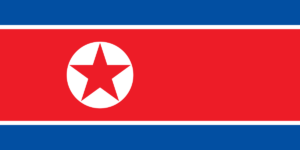
Since the conclusion of the Korean War in 1953, the Korean Peninsula has been divided along the 38th parallel, forming two countries: North Korea and South Korea. North Korea, which follows a communist ideology, has had three successive rulers of the same family: Kim Il-sung, Kim Jong-il, and currently Kim Jong-un. Their leadership and ideologies have been a consistent area of conflict since the establishment of the regime. With heavy sanctions on their country placed by the United Nations and a call to keep them from achieving nuclear capabilities, North Korea has often remained on the side lines. In recent months, however, Kim Jong-un has brought North Korea into the lime light once more.
January 1, 2017
Kim made the announcement that North Korea could soon test an intercontinental ballistic missile. In response, former U.S. Secretary of Defense, Ash Carter, stated plainly that any ballistic missile launched at the United States would be shot down.
July 4, 2017
There is another missile test, which North Korea claimed could reach anywhere in the world. Shortly following this test, North Korea threatened to launch a nuclear strike on the heart of the U.S. if there are ever attempts to remove Kim Jong-un from power.
August 7, 2017
North Korea accused the United States of attempting to force the Korean Peninsula into a nuclear war. This was stated after the United Nations Security Council unanimously voted for new sanctions in response to the ballistic missile tests in July.
August 9, 2017
The threat of a North Korean attack became visible in the eyes of the world. Despite North Korea’s claims in their abilities to strike anywhere in the world with a missile, countries were not concerned since the furthest their missiles had gone before was 2,300 miles, which is just past Japan. On Aug. 9, however, the North Korean military announced they were “examining the operational plan” to strike areas around the territory of Guam with medium-to-long-range strategic ballistic missiles. Guam is only 2,100 miles away from North Korea and therefore within their missile launch zone. This announcement followed one day after President Donald Trump warned North Korea that any more threats towards the United States would cause “fire and fury like the world has never seen.” Since then, Kim Jong-un’s regime and the Trump administration have been sending threat after threat to one another.
September 3, 2017
North Korea carried out its sixth test of a nuclear weapon which caused a 6.3 magnitude seismic event, as measured by the United States Geological Survey. North Korea claimed the explosion to have been from a hydrogen bomb that could be placed on an intercontinental missile. A nuclear weapons monitoring group described the weapon as up to eight times stronger than the bomb dropped in Hiroshima in 1945. President Trump responded to the test by tweeting that North Korea continued to be “very hostile and dangerous to the United States,” and went on to criticize the South Korean government by claiming the country is engaging in “talk of appeasement” with North Korea. President Trump then went on to call North Korea “an embarrassment to China,” and claims Beijing is having little success reigning in Kim Jong-un’s regime.
September 15, 2017
President Donald Trump spoke at Joint Base Andrews, the Air Force installation outside Washington, where he emphasized the strength of the U.S. military options, saying, “After seeing your capabilities and commitment here today, I am more confident than ever that our options in addressing this threat are both effective and overwhelming.” His statement was directed at North Korea and Kim Jong-un’s regime. On Saturday, September 16, National Security Advisor H.R. McMaster made it clear that time was running out to deal with North Korea, saying, “For those who have said, and been commenting about a lack of an military option, there is a military option,” later adding, “Now, it is not what we would prefer to do.” However, he, made it clear that the United States is considering military actions against North Korea should they be necessary.
As of now, that is where the situation in North Korea stands. With tensions escalating across the globe, it is rather unclear where this may lead. But, the Trump administration is weighing all of their options and working with other countries within the United Nations countries to resolve the situation.
Compline Service Introduced
by The Cowl Editor on September 21, 2017
Campus
St. Dominic Chapel Offers Weekly Night Prayers on Monday Nights
By Thomas Edwards ’20
News Staff
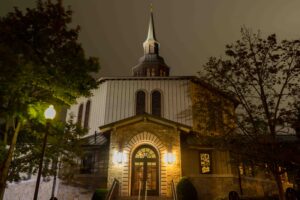
Starting this semester at Providence College, St. Dominic’s Chapel has begun holding Compline Services every Monday night after the 9 p.m. mass. This came about from Daniel Arteaga ’19, the Campus Ministry Board’s student minister for worship.
With the task of finding events to engage students through liturgy and worship, Arteaga immediately thought of Compline as being the perfect service to do so.
“It was prayed among students beforehand, kind of in-between friend groups and things. It’s an official prayer of the church and something that the Friars pray all the time too, as well as the sisters,” said Arteaga. “So to kind of bring it out into the public, say come together and let’s pray Compline together, I just thought it’d be a lot of fun and kind of a cool Dominican way of celebrating a devotion and prayer together.”
Father Peter Martyr Yungwirth, O.P. , the chaplain at Providence College, runs the services. “When Arteaga asked if we could do this, I thought it was a great way to share part of the Dominican life and the Dominican way of praying with the students as well,” said Fr. Peter Martyr.
Compline Service is part of the Liturgy of Hours, which is a series of prayers said throughout the day by Friars and Sisters alike, which Fr. Peter Martyr said he “first experienced in my small community at University of Maryland.”
Compline service is not something that all Catholics have heard of, so when Arteaga asked Fr. Peter Martyr about doing it he said, “Let’s just give it a shot and see what happens,” which is why it is currently only held on Monday nights, but depending on how well things work out this first semester, the services could move to more than one night a week.
“It aims at really fostering the prayer life,” said Arteaga. “The main goal is to foster lives of prayer, lives that are closer to the Lord, and lives that are really entangled with community.”
Compline Service is not only for Catholics, however. Fr. Peter Martyr described the prayers as being “to God himself, but, they’re kind of situational and that’s kind of the beautiful thing about the Liturgy of the Hours is that the different prayers throughout the day are particularly for what is happening at that time of day and to help you come to a relationship with the Lord at that moment.”
It is a service that all are welcome to attend, with the goal of just entering the rest of your night with “a more peaceful, restful place in [your] heart,” said Fr. Peter Martyr.
As for the service itself, “it’s like the Catholic calisthenics,” said Arteaga on his first time attending the service himself. “I started getting into the hang of it, now those movements were second nature in a sense so I could start paying attention to the words and to the song.” It might be hard to follow at first, but eventually one gets the hang of it and soon “the texts and the songs start to really, really sink in.” Participation in the prayer will help students to relax and feel ready to take on the week.
Understanding DACA on a National Level
by The Cowl Editor on September 14, 2017
National and Global News
Bursting the PC Bubble: What is DACA?
By Thomas Edwards ’20
News Staff
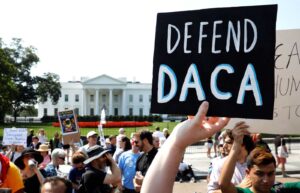
Last week, on Tuesday, September 5, through the words of Attorney General Jeff Sessions, President Donald J. Trump rescinded Deferred Action for Childhood Arrivals.
DACA was an American immigration policy established by the Obama administration in June of 2012. The policy gave protection from deportation to undocumented minors for renewable two-year periods, and allowed them to work in the U.S. As of 2017, approximately 800,000 individuals were protected from deportation by DACA.
For the time being, the rescinding of DACA has been delayed for six months in order to give Congress the chance to find a solution for the 800,000 young people currently under the policy and those who were previously eligible.
DACA received mixed responses when it was first initiated and has received nothing less with its termination. Democrats in Washington have especially been vocal about the issue, most of, if not all, denouncing the decision. House Minority Leader Nancy Pelosi said, “President Trump’s decision to end DACA should break the hearts and offend the morals of all who believe in justice and human dignity.” Pelosi, with other Senate and House Democrats, has called on her Republican counterparts to work with the Democrats to form a solution. Rahm Emanuel, Mayor of Chicago, announced a half an hour before the Trump administration’s announcement that “DACA will continue to exist in Chicago,” calling the termination of the program “morally, politically, and economically wrong.”
While the response from Democrats has been largely unanimous, there have been mixed responses from the Republican Party.
Senate and House Republicans have announced their opposition to Trump’s decision to end DACA, among them Senator John McCain from Arizona. McCain said, “President Trump’s decision to eliminate DACA is the wrong approach to immigration policy at a time when both sides of the aisle need to come together to reform our broken immigration system and secure our border… I strongly believe that children who were illegally brought into this country through no fault of their own should be forced to return to a country they do not know.”
Just as there have been Republicans speaking against Trump, there have been those standing behind him. Senate Majority Leader Mitch McConnell said, “President Obama wrongly believe he had the authority to re-write our immigration law. Today’s action by President Trump corrects that fundamental mistake.”
Joining McConnell is House Speaker Paul Ryan who opposed the program when Obama implemented it and hopes Congress can find a permanent solution. “It is my hope that the House and Senate, with the President’s leadership, will be able to find consensus on a permanent legislative solution that includes ensuring that those who have done nothing wrong can still contribute as a valued part of this great country,” said Ryan in a statement after the announcement. Most Republicans speaking in favor of President Trump’s decision have agreed on the unconstitutionality of Obama’s executive decision creating the program and that it should now be instated, though not verbatim, by Congress instead. “I have long supported accommodating those brought to this country illegally through no fault of their own; however, I have always felt that President Obama’s executive action was unconstitutional and that the right way to address this issue was through legislation,” said Senator Marco Rubio.
Lawmakers have not been the only group to speak out openly in response to last Tuesday’s events. Facebook founder Mark Zuckerberg stated, “This is a sad day for our country.” Mark Ruffalo tweeted, “A cowardly act by a cruel, vindictive and heartless administration intent on tearing at the very fabric of the American dream.” Along with tweets and comments from celebrities, there have also been protests and marches, including one Tuesday which marched from the White House toward Trump International Hotel after the announcement.
While opinions from both sides have been voiced, the one common consensus is that now it is up to Congress to pick up the pieces. President Trump reportedly called on Congress to “legalize DACA,” to legislate a program similar to Former President Obama’s, which was created through executive authority, or he will “revisit [the] issue!”
“It is important that the White House clearly outline what kind of legislation the president is willing to sign. We have no time to waste on ideas that do not have the votes to pass or that the president won’t sign,” said Rubio. Other legislators expressed thier desire to continue to give protection to the children. “We must protect children who are already here in this country and those who are currently protected under DACA. That principle is fundamental for me. It’s also clear that we must work in Congress to provide long-term certainty for DACA recipients,” said GOP Representative Cathy McMorris Rodgers. In a simliar spirit, Democratic Senate Whip Dick Durbin said, “It is time for us in Congress to do the right thing.”
